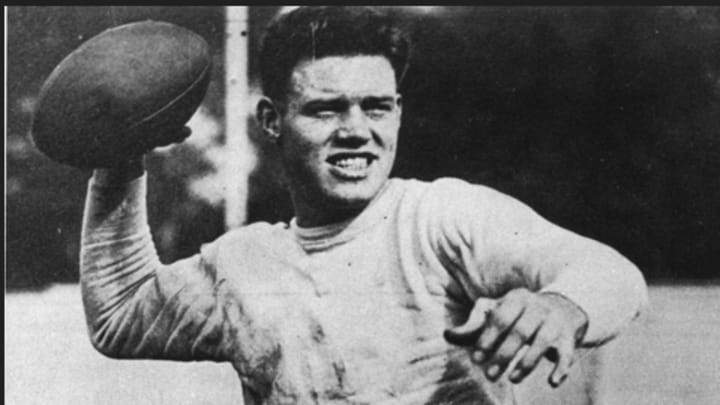Top 50 Cal Sports Moments -- No. 5: The Pass, 1921

As the Pac-12 Conference era comes to a close after more than a century, we count down the Top 50 moments involving Cal athletics.
THE MOMENT: In the second quarter of the January 1, 1921, Rose Bowl game against Ohio State, Cal’s Harold "Brick" Muller produced a play that changed the complexion of college football. Cal led the heavily favored Buckeyes 7-0, when Muller let loose with a pass that brought gasps from the crowd of 42,000 at Tournament Park in Pasadena, much like spectators viewing a launch at Cape Canaveral. It produced what was officially called a 37-yard touchdown pass, but witnesses insist the ball traveled 70 yards in the air. Objective observers whittled it down to a 53-yard pass, but it was still an otherworldly throw at the time. It gave Cal a 14-0 lead, and as San Francisco Chronicle reported the next day, “The play killed Ohio.” It also killed the notion that West Coast football was vastly inferior to Midwest and Eastern college football, as the Bears’ waltzed to a 28-0 victory.
THE STORY: Even though the 1920 Golden Bears were 8-0 and had outscored their opponents 482-14, they were not given much of a chance against 7-0 Ohio State in the 1921 Rose Bowl, then known as the Tournament East-West Game. West Coast football was considered minor-league competition compared with the powerhouses of the East and Midwest. It was similar to Super Bowl III, when Joe Namath and the Jets of the belittled AFL were expected to get crushed by the Baltimore Colts of the tradition-rich NFL.
To everyone’s surprise Cal dominated Ohio State 28-0, changing the way the country viewed West Coast football. Despite the magnitude of the upset, the reports the next day focused on one play in the second quarter, a play that transformed popular opinion in what the San Francisco Chronicle called “one of the greatest upsets in the history of the gridiron game.”
It came on a trick play called by head coach Andy Smith with Cal holding a 7-0 lead, and it occurred on second down from the Ohio State 37-yard line. The play began with Cal’s Archie Nisbet faking an injury. But as he hobbled toward the sidelines, he picked up the ball and lateraled to Pesky Sprott, who was six or seven yards behind the line of scrimmage and began heading to the left sidelines. Pursued by Ohio State defenders, Sprott stopped and threw that ball across the field to Muller, an end who was about 10 yards in back of Sprott just beyond midfield.
Muller then let loose with a pass that went higher and farther than anyone had ever seen, bringing a noticeable hush to the crowd. Passing was not a major part of teams’ offenses in those days, partly because the ball at the time resembled a rugby ball and did not lend itself to long or accurate passes. In the meantime, Cal’s Brodie Stephens had run well past the Ohio State defenders, none of whom expected anyone to throw the ball as far as Muller did. Stephens caught the missile at the goal-line and fell back into the end zone.
Muller later threw a 40-yard touchdown pass that was called back because of a penalty, but the stories the next day all focused on the pass that traveled over 50 yards, according to reporters who did not have the benefit of a video replays.
“In a game that was filled with thrills and exciting situations, the 50-yard pass from Muller to Stephens stands out like the Campanile,” wrote Ed R. Hughes of the San Francisco Chronicle.
Even two days after the game, the Muller pass was a focal point in the Chronicle. “That throw of his to Stephens will be used as the basis of comparison for all other throws for years to come.” And Muller was just a sophomore end, not even a member of the backfield.
The throw, and the resulting victory, changed the way West Coast football was viewed. That 1920 Cal team was the first of four straight Golden Bears teams that were named national champions by at least one reputable body. Muller was named All-America in 1921 and 1922.
The Jets’ victory over the Colts gave the AFL instant credibility and forced a merger, but it’s nearly impossible to name a single play in any sport that dramatically changed the perception of the game as dramatically as Muller’s 53-yard pass did.
*Top 50 Moment No. 7: Andy’s Death
Only specific acts that occurred while the team or athlete was at Cal were considered for the Top 50 list, and accomplishments spanning a season or a career were not included.
Follow Cal Sports Report on Twitter: @jakecurtis53
Find Cal Sports Report on Facebook by going to https://www.facebook.com/si.calsportsreport
